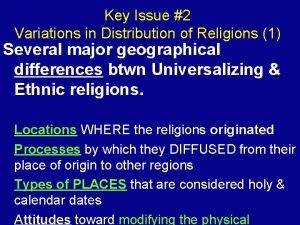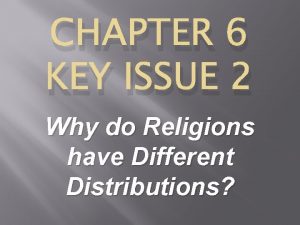Chapter 6 Key Issue 3 Why Do Religions




- Slides: 4

Chapter 6 Key Issue 3 Why Do Religions Organize Space in Distinctive Patterns?

Places of Worship n n Religion impacts the landscape in a variety of ways. Christian churches were originally modeled after Roman basilicas. Mosques are the most important religious buildings in the Islamic world, and they also serve as places for the community to gather. Most Hindus worship at home, although Hindu temples serve as shrines to one or more of their gods. The pagoda is the most visible religious architecture of the Buddhist and Shintoist landscape, and contains the relics of Buddhism.

Sacred Space n n Burial practices of different religions are also visible on the landscape. Christians, Muslims, and Jews usually bury their dead in cemeteries. Place names or toponyms also show the impact of religion on the landscape. For example, many Roman Catholic places are named for saints. Cremation has replaced burial as a means of disposing of the dead in many parts of the world because of the pressure on agricultural land. This is particularly true in China and western Europe. Cremation is also used in the Hindu world, although it is putting an increasing strain in India’s wood supplies.

Administration of Space n n n The Roman Catholic Church is a good example of a hierarchical religion, with its well-defined geographical structure and division of territory into local administrative units. Archbishops report to the Pope and each heads a province. Bishops report to archbishops and administer a diocese. The headquarters of a bishop is called a “see” and is usually the largest city in the diocese. Islam and some Protestant denominations are good examples of autonomous religions because they are relatively self-sufficient, with little interaction between communities within the religion.







